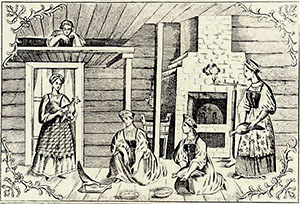Alectromancy

Peasants using chickens for divination.
19th Century Russian lubok.
Alectromancy (also spelt alectryomancy) can be compared to the modern day practices of planchette and use of the oujja board. It refers to the ancient art of practicing divination using a cock to foretell the future.
When the sun or the moon is in Aries or Leo, a circle with as many parts as the letters in the alphabet is drawn within a confined space. A wheat corn is placed in each division and incantations follow. Based on the letters from which the cock pecks grain, the name of the individual concerning whom the enquiry has been made is revealed.
Legend says the sorcerer Lamblicus used this method to unearth the successor of Valens Caesar in Rome. When the bird pecked at just four letters spelling 'T h e o', the sorcerer had all the people whose names begun with these letters killed. This was followed by a large scale wipe out of many sorcerers and philosophers in Rome by royal order.
In the fourth century, a variation of the above was followed wherein the magicians would first place a metallic basin on the ground surrounded by letters of the alphabet. The most senior magician would then hold the branches of the Vervain and chant incantations followed by convulsions rocking his body. At this point he would hit at the letters of the alphabet and when a sufficient amount had been gathered to form a verse, it would be announced to the waiting public.
"It is a very mysterious divination, in which they made use of a cock in discovering secret and unknown transactions or future events. The method was this; they first wrote on the dust the 24 letters of the alphabet, and laid a grain of wheat or barley upon every one of them; then having prepared a cock magically, they let him loose among them, and those letters out of which he picked the corns being put together, were thought to declare whatever they had a mind to know."
Universal Etymological Dictionary, Norman Bailey (1727)
